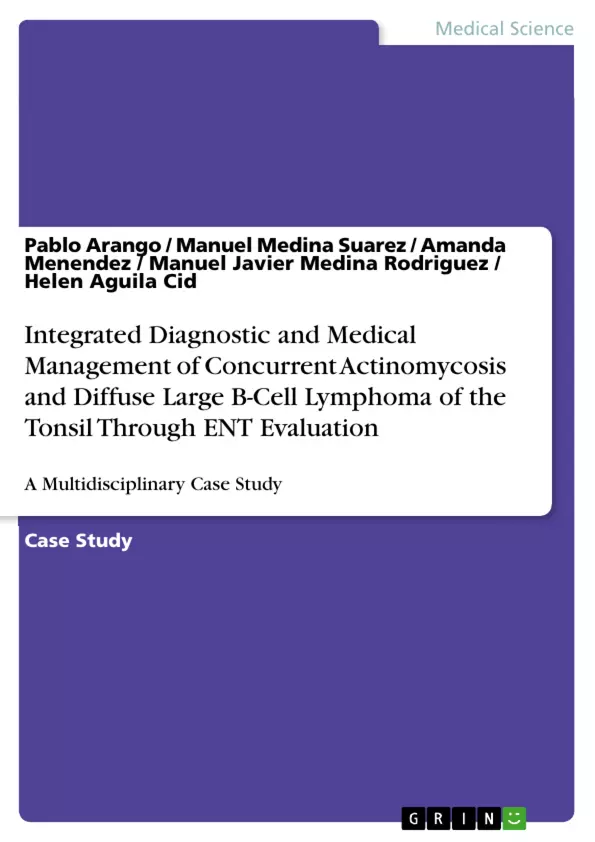This case study of a 75-year-old female patient who presented with a suspicious neck mass. Extensive diagnostic efforts, including histopathology, PET-CT imaging, and hematopathology consultation, revealed a complex presentation in which the first biopsy was positive for actinomycosis without tumor cells, while a second more profound biopsy revealed and confirmed the coexistence of diffuse large B – cell lymphoma. This case emphasizes the importance of a multidisciplinary approach to diagnosis and treatment.
Table of Contents
- Abstract
- Case Presentation
- Discussion
- Conclusion
Objectives and Key Themes
The objective of this case study is to detail the clinical presentation, diagnostic process, and treatment of a 75-year-old female patient with a complex presentation of actinomycosis and diffuse large B-cell lymphoma of the tonsil. The case highlights the challenges of diagnosing and managing advanced oropharyngeal tumors in elderly patients, emphasizing the importance of a multidisciplinary approach.
- Diagnostic challenges in distinguishing between infectious and malignant processes in oropharyngeal lesions.
- The importance of a multidisciplinary approach to the diagnosis and treatment of complex head and neck conditions.
- The complexities of managing concurrent infectious and malignant diseases.
- The impact of prior medical history on diagnosis and treatment strategies.
- Treatment strategies for diffuse large B-cell lymphoma.
Chapter Summaries
Abstract: This abstract summarizes a case study of a 75-year-old woman diagnosed with both actinomycosis and diffuse large B-cell lymphoma in her left tonsil. It highlights the difficulties in diagnosis due to the initial biopsy showing only actinomycosis and the subsequent need for a second, more extensive biopsy to reveal the lymphoma. The case emphasizes the importance of a multidisciplinary approach to diagnosis and treatment of such complex cases.
Case Presentation: A 75-year-old female presented with a one-month history of throat irritation, difficulty swallowing, voice changes, and pain. Initial examination revealed a hypertrophic left tonsil with yellowish exudate. A throat culture showed normal flora, but blood work showed elevated sedimentation rate. A CT scan showed a left oropharyngeal mass. An initial biopsy revealed actinomycosis, leading to treatment with doxycycline. However, a subsequent PET-CT scan showed extensive tumor involvement, prompting a second biopsy which confirmed diffuse large B-cell lymphoma. This chapter details the patient's symptoms, initial diagnostic tests, and the progression to a definitive diagnosis.
Discussion: This section discusses diffuse large B-cell lymphoma (DLBCL), its prevalence, and diagnostic challenges. It emphasizes the rarity of tonsillar DLBCL and the difficulties in distinguishing it from other oropharyngeal pathologies, particularly in the presence of concurrent infections like actinomycosis. The discussion highlights the importance of considering both infectious and malignant processes in the differential diagnosis of tonsillar masses and emphasizes the need for a multidisciplinary approach involving specialists in oncology, infectious disease, and otolaryngology. The discussion also touches upon the role of immunohistochemical staining in the accurate diagnosis of the lymphoma subtype.
Keywords
Diffuse large B-cell lymphoma, actinomycosis, tonsil cancer, oropharyngeal cancer, multidisciplinary approach, diagnostic challenges, geriatric oncology, PET-CT, biopsy, immunohistochemistry, head and neck cancer.
Frequently asked questions
What is the main topic of the language preview?
The language preview pertains to a case study focusing on a 75-year-old female patient diagnosed with both actinomycosis and diffuse large B-cell lymphoma of the tonsil. It explores the diagnostic and treatment challenges associated with such complex cases.
What are the key themes explored in the language preview?
The key themes include:
- Diagnostic challenges in distinguishing between infectious and malignant processes in oropharyngeal lesions.
- The importance of a multidisciplinary approach to the diagnosis and treatment of complex head and neck conditions.
- The complexities of managing concurrent infectious and malignant diseases.
- The impact of prior medical history on diagnosis and treatment strategies.
- Treatment strategies for diffuse large B-cell lymphoma.
What does the abstract summarize?
The abstract summarizes the case study of the 75-year-old woman, highlighting the difficulty in initially diagnosing diffuse large B-cell lymphoma due to the presence of actinomycosis in the initial biopsy. It emphasizes the need for a second biopsy and a multidisciplinary approach.
What were the patient's initial symptoms and examination findings?
The patient presented with a one-month history of throat irritation, difficulty swallowing, voice changes, and pain. Initial examination revealed a hypertrophic left tonsil with yellowish exudate.
What were the results of the initial diagnostic tests?
A throat culture showed normal flora, but blood work showed an elevated sedimentation rate. A CT scan revealed a left oropharyngeal mass. The initial biopsy revealed actinomycosis.
Why was a second biopsy performed?
A subsequent PET-CT scan showed extensive tumor involvement, prompting a second biopsy to rule out other potential diagnoses, which then confirmed diffuse large B-cell lymphoma.
What are some of the diagnostic challenges discussed?
The discussion highlights the difficulties in distinguishing tonsillar DLBCL from other oropharyngeal pathologies, especially when concurrent infections like actinomycosis are present.
What is the significance of a multidisciplinary approach in this case?
A multidisciplinary approach involving specialists in oncology, infectious disease, and otolaryngology is crucial for accurate diagnosis and effective management of complex cases involving both infectious and malignant processes.
What is the role of immunohistochemical staining?
Immunohistochemical staining plays a significant role in the accurate diagnosis of the lymphoma subtype, helping to differentiate it from other similar conditions.
What keywords are associated with this case study?
The associated keywords include: Diffuse large B-cell lymphoma, actinomycosis, tonsil cancer, oropharyngeal cancer, multidisciplinary approach, diagnostic challenges, geriatric oncology, PET-CT, biopsy, immunohistochemistry, head and neck cancer.
- Quote paper
- Pablo Arango (Author), Manuel Medina Suarez (Author), Amanda Menendez (Author), Manuel Javier Medina Rodriguez (Author), Helen Aguila Cid (Author), 2025, Integrated Diagnostic and Medical Management of Concurrent Actinomycosis and Diffuse Large B-Cell Lymphoma of the Tonsil Through ENT Evaluation, Munich, GRIN Verlag, https://www.grin.com/document/1582477



